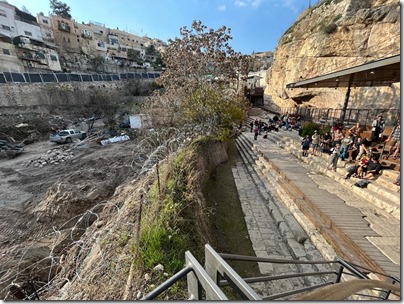Archaeologists have now finished a chronological mapping of Megiddo, with radiocarbon dates for the two dozen layers of habitation from the Early Bronze Age to the end of Iron II.
Archaeologists excavating a deep rock-hewn moat along the northern side of Jerusalem’s Old City walls have discovered a handprint carved into the stone.
Not all scholars agree that the name of David is on the Mesha Stele.
The Technion and the University of Haifa’s School of Archaeology and Maritime Cultures have launched a joint initiative to support cooperation between the two institutions in archaeological sciences, especially microarchaeological research.
“Benjamin Netanyahu reportedly promised King Abdullah II that the status quo on the Temple Mount in Jerusalem will be preserved.”
“Jerusalem’s Tower of David was never built to be accessible.” The Times of Israel gives the backstory on the ingenuity required to make the ancient fortress accessible to those with disabilities.
Chandler Collins writes about a significant geographical feature in Jerusalem that he calls the “Fortress Saddle.” This was the city’s most vulnerable area on its most vulnerable side.
The Mardigian Museum has opened in Jerusalem’s Armenian Quarter, documenting the community’s history and serving as a memorial to the Armenian Genocide.
“A riveting new exhibition, titled ‘Peace and War: The Assyrian Conquest of Lachish,’ will open on January 30 in the Lynn H. Wood Archaeology Museum on Southern Adventist University’s campus.” I’m not sure how much “peace” was involved in the Assyrian conquest.
Excavations at ancient Capitolias, a city of the Decapolis in modern Jordan, are shedding light on the production of glass in the Roman, Byzantine, and Umayyad periods.
A former director of the Citadel Museum in Amman, Jordan, was convicted of stealing 6,000 ancient coins and replacing them with forgeries.
Oded Lipschits will be giving a series of lectures in the UK in honor of the Anglo-Israel Archaeological Society’s Diamond Jubilee between February 20 and March 6. One of them will be online: “New Light on Jerusalem and its Surroundings during the Reign of King Manasseh,” on March 2. Registration required.
Preserving Bible Times has released The Bible: Its Land and Culture, Session 4, including Galilee aerial videos, cultural vignettes, and biblical culture.
Nathan Steinmeyer gives advice on finding the right archaeological dig to join. This is also the topic of an OnScript Biblical World podcast with Steinmeyer, Chris McKinny, and Kyle Keimer.
HT: Agade, Joseph Lauer, Arne Halbakken, Ted Weis, Explorator
Excavations at the Pool of Siloam this week; photos by John Black

